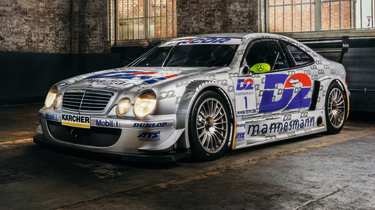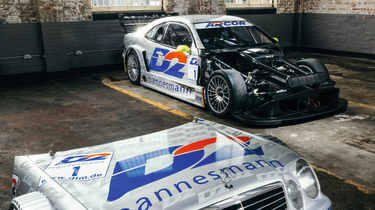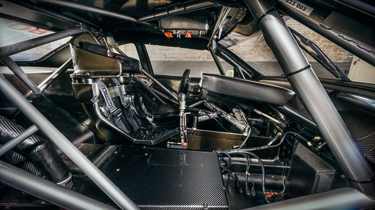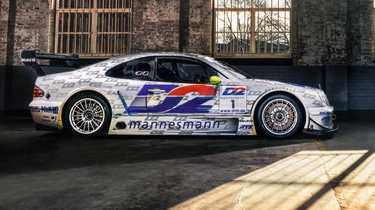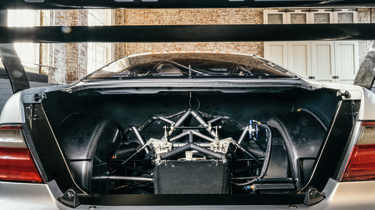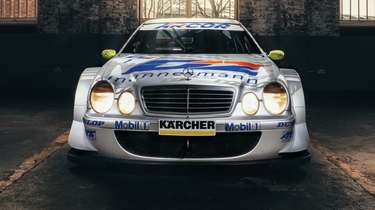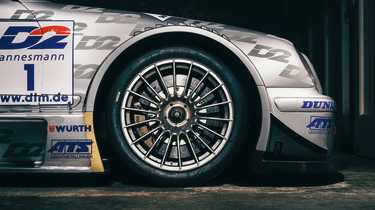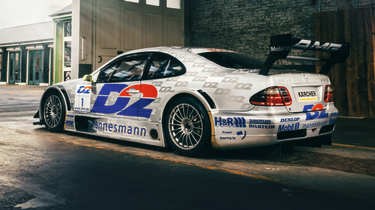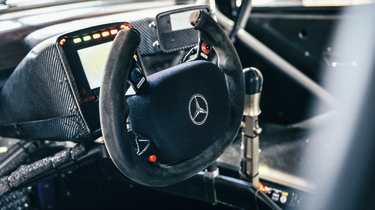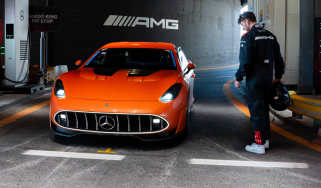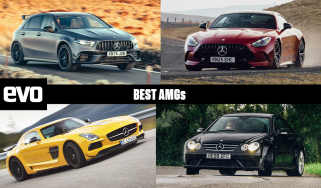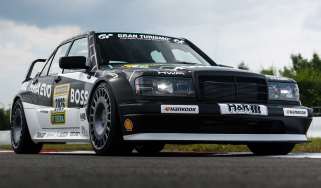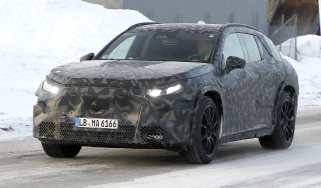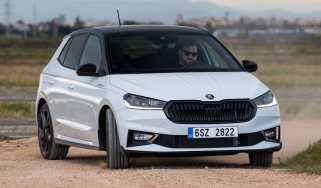Mercedes CLK DTM: the anatomy of the 2000s V8 touring car
In 2000, the DTM was reborn with a new rule‑set, a new ethos and a new hero car, the Mercedes CLK DTM. We look under its skin
Like the fall of the Roman Empire, the 1990s era of DTM (latterly the International Touring Car Championship) burned itself out in an unsustainable orgy of unlimited budgets and extraordinary technology. The combination of spectacular cars, proud brands, vast budgets and stellar drivers was undeniably epic, but it all came to an inevitable end at the close of 1996.
After a three-year hiatus, the 2000 season was a new beginning for the beleaguered DTM series. It carried the same initials, but those evocative three letters hid a subtle change of name, the Deutsche Tourenwagen Meisterschaft retitled as Deutsche Tourenwagen Masters as early plans for a significant number of races to be held outside of Germany meant the German Motor Sport Federation (DMSB) wouldn’t bestow national championship status upon the revamped series.
> Ford Sierra RS500: the anatomy of a BTCC racer
Still, the principle of the new DTM was clear: costs should be kept within reasonable limits and the racing should be close. In short, every car that lined up for the start should be capable of winning the race.
Speaking at the 2000 season launch, Mercedes motorsport boss Norbert Haug said: ‘The DTM is no attempt at engaging in a technical arms race. Instead, it is to provide fascinating hands-on motorsport with familiar-looking cars. It is not a question of incorporating the latest high-tech solutions. We want fans to watch spectacular motorsport at the lowest possible costs.’
The new DTM would enjoy full support from Mercedes-Benz and Opel. Audi joined through factory-supported privateers Abt, though the TT relied upon special dispensation due to its dimensions falling outside the regulations. The obvious absentee was BMW, who had made encouraging noises about joining the series but then took the late decision to focus all its resources on expanding its Formula 1 efforts.
These new-generation DTM cars were built around a prescriptive and – crucially – economically viable set of regulations that still allowed for full factory teams but kept a tight rein on engine and aerodynamic development. With more freedom than a true spec formula, but tight controls to avoid rocketing budgets, this new beginning would serve DTM well, with the series continuing under the same regulations until the end of the 2018 season.
Racing history
This particular car – CLK DTM 001 – is HWA’s test and development car for that inaugural 2000 season. Though it never raced, most of AMG’s factory drivers spent time in it, including Klaus Ludwig, Thomas Jäger and Marcel Fässler. However, it was Bernd Schneider – Herr DTM himself! – who conducted the majority of the development programme during the early part of 2000, running the CLK at Jarama in Spain, Vallelunga in Italy and German circuits Oschersleben and Hockenheim.
He clearly did a brilliant job of honing the car, for he would go on to win the 2000 season in dominant fashion, fending off stiff opposition from AMG teammate Ludwig and works Opel ace Manuel Reuter.
As promised, the racing was close and spectacular with plenty of door-to-door action as the biggest touring car stars went at it hammer and tongs. Schneider began in ominous fashion, winning both races of the opening weekend at Hockenheim. Reuter would mount a comeback and Ludwig would also feature – the pair ultimately finishing the season in 2nd and 3rd positions respectively – but as the season progressed Schneider rarely put a foot wrong. By season’s end he would post six race wins and 12 podiums from 16 starts, with four pole positions and nine fastest laps for good measure. It was an emphatic performance from a driver at the peak of his powers, and he would go on to a hat-trick of titles in 2000, 2001 and 2003.
According to Schneider, both he and Mercedes really hit the ground running: ‘In 2000 we had a really, really good car. It had a good balance. We had good aerodynamics and good mechanical grip. We were struggling a little with horsepower, so we did better on the tighter, twistier circuits, but overall we had enough pace and the consistency and reliability was excellent. The CLK was a great package. Also, I was determined to win that 2000 season. I did all the pre-season tests because this was going to be the most important season of my life.’
Having laid the foundations for AMG’s extraordinary DTM title hat-trick, CLK DTM 001 was subsequently sold by HWA in 2004 to Brazilian billionaire businessman, racer and car collector Alcides Diniz, the uncle of ’90s F1 driver Pedro Diniz. Once in Brazil – and sporting a hastily attached production car VIN to, er, ‘ease’ import duties – the CLK spent most of its time being driven at Diniz’s private Autódromo Capuava race track. However, it did do one race – the 2006 ‘Mil Milhas of Interlagos’ – where it was driven to 2nd place by Tony Kanaan, Raul Boesel and Pedro Lamy.
After Diniz passed away later that same year, CLK DTM 001 was subsequently sold to a European collector who has since enjoyed using it on trackdays. Now for sale with Bicester Motion-based Sports Purpose (sports-purpose.com) it presents a rare opportunity to acquire a significant piece of DTM history.
Body, chassis and aerodynamics
Central to the new-look DTM philosophy was its silhouette formula. It was something of a reset after the excesses of the previous DTM and ITC, but although the 2000 season cars might have looked closer to their showroom counterparts, the visual resemblance belied the fact the new race cars borrowed the bare minimum from the production models. In fact, for the most part the bodywork was carbonfibre – in the CLK’s case, only the roof and door skins used sheet metal carried over from the road car. Oh, and not forgetting the incongruous chrome CLK55 badge on the bootlid.
Nevertheless, to be eligible to race in DTM the chosen model had to be derived from a series-production model of which at least 10,000 units had been built within a 12-month period. The regulations also stated that eligible production cars should be two-door four-seaters, with strict dimensional limits including a minimum wheelbase of 2500mm, overall length between 4300mm and 4700mm, a minimum height of 1350mm and maximum width (not including mirrors) of 1850mm. Minimum weight was 1080kg including the driver.
The CLK DTM, as with all cars built to the 2000 regs, is based upon a bespoke tubular spaceframe chassis to which the engine, suspension and transmission are attached. Safety was a high priority for the new-era DTM cars, and to this end drivers sat within a carbonfibre safety cell, which effectively formed a single-seater-style tub enclosing the seat, head restraints, pedals, gear shifter, steering column mounting point and seat harness.
Being located towards the centre of the safety cell presented quite a challenge for drivers to clamber in, and all had to prove they could exit via the driver’s door within seven seconds or out through the passenger door within nine. A front crash structure, also made from carbonfibre and measuring almost 1m in length was mounted centrally between two cooling radiators and designed to absorb heavy frontal impacts. Rigid foam elements in the doors protected the driver in the event of a lateral crash. In addition, the CLK DTM featured airbags to further protect the driver. Together these measures formed the basis of a new concept for touring car safety.
The scope for aerodynamic development was deliberately limited, with little freedom for manufacturers to attempt to find a performance advantage. Most of the CLK’s underbody is flat, and while the rear wing and diffuser are impressive they conformed to regulations that standardised these areas between rival cars. The only real area free for aerodynamicists to explore ideas was the front end, with the first 900mm free to develop in the pursuit of downforce.
According to Bernd Schneider, the regulations were smart because the front end remained limited in terms of the amount of downforce it could generate, which naturally limited the amount of downforce that could be run at the rear and still retain a decent aero balance. Within a few years the cars would sprout more aggressive front dive-planes, but for 2000 the cars retained a surprisingly clean shape. One which belied the potency and performance of these purer and simpler machines compared with their wild-looking predecessors.
Engine and gearbox
Standardised components were central to the new 2000-season DTM. After the mid-90s arms race, in which manufacturers developed exotic engines that revved to 13,000rpm, the new-generation cars followed a far more prescriptive recipe. Not only for powertrain hardware, but also the engine’s positioning relative to each car’s wheelbase centre.
The basic blueprint for the new engines was a 4-litre naturally aspirated 90-degree V8. They didn’t have to be production-based, but Mercedes took advantage of its recent GT1 endurance racing programme, which had seen the spectacular V12-engined CLK GTR evolve into the V8-engined CLK LM for the 1998 season. This engine was loosely derived from the M119 V8 production engine, a turbocharged version of which had previously been used in the Mercedes-powered Sauber Group C cars. HWA returned to this engine block casting to form the basis of its new DTM engine.
Strict weight and material specifications meant manufacturers couldn’t throw budget at F1-style engine development. Titanium could only be used to a very limited extent, and ceramics were banned. In any case, with engines having to weigh at least 165kg and the top end having to make up at least 55kg of this total, there was nothing to gain from extreme lightweighting of components.
All cars were fitted with a pair of 28mm air restrictors to limit power and revs. Peak power was circa 460-470bhp with around 300lb ft, while engines revved to no more than 8000rpm. Engine management systems were standardised in line with DTM’s vow to limit the extent of electronics. Engines could not be replaced during the racing season, either. They were sealed at the start of the racing year and there were severe penalties if an engine needed to be replaced.
All 2000 DTM cars used the same six-speed transaxle supplied by British transmission company X-Trac. Mounted directly in front of the rear axle, the gearbox was operated sequentially via a hefty push-pull lever. A standard mechanical limited-slip differential was fitted, but no hydraulic or electronic assistance or control systems were permitted. The six gear ratios were fixed – again to avoid additional costs – but teams could change overall gearing for both tight circuits and faster, more open tracks thanks to a choice of different final drive ratio.
Suspension, tyres and brakes
With bodywork removed, the CLK DTM looks more like a single-seater with double wishbones fabricated from steel. These transfer dynamic forces to the springs and dampers via pushrods. The dampers – supplied by Bilstein – are adjustable for low and high-speed bump and rebound. Springs and anti-roll bars could be changed, but no electronics were allowed. Likewise, no form of traction control other than the driver’s right foot.
For the 2000 season, Dunlop supplied a control SP Sport Maxx tyre for all competitors. The front tyres were 240/640-R18 mounted on 10in rims with the rears slightly wider at 280/650-R18 on 12in rims. Tyre management was key, with just five sets allocated for each race weekend, which comprised practice and qualifying sessions followed by two 40-minute races separated by a scant 15-minute interval.
Brakes were standardised and limited to three sets per season. Supplied by AP Racing, the 380mm carbon/carbon discs are 32mm thick and internally vented. AP also supplied teams with its ‘Radi-Cal’ six-piston calipers. ABS, though, was prohibited.
Driving them: Bernd Schneider
‘The DTM programme’s chief engineer was a guy called Gerhard Ungar. His target was never pole position. Rather he really concentrated on race speed and consistency. I did get a few pole positions, but the CLK’s race pace was the key to our success.
‘In 2000, the challenge was that everyone was on the same tyre. In the old days we had Michelin and Bridgestone supplying tyres, so there was a bit of a tyre war going on. In 2000, Dunlop was the sole supplier. There was no qualifying tyre, so we only had tyre pressures, camber settings and some very slight adjustment in downforce settings available to us.
‘In the old DTM cars, there was so much adjustment and technology – including active suspension and dynamic ballast which would move to optimise weight distribution during the lap – you could set it up perfectly for each corner. It was really tricky to get everything perfect, but you could do it.
‘In the 2000 car we only had a choice of springs and high- and low-speed bump and rebound settings on the shocks. It was much more a case of finding the best compromise. It was back to the roots, finding different solutions and adapting your driving.
‘They were quite physical to drive, but we had power steering so they were no harder than the old C-class. The CLK had side-exit exhausts so heat wasn’t an issue, whereas the C-class had the exhausts running down the transmission tunnel, so our feet and legs got really hot. There wasn’t much between the old and new era cars in terms of lap time. The 2000 car was somewhere around 8/10ths slower than the ’96 C-class in qualifying, but then the old cars had around 520bhp and lots of aero. The tyres were small, but we had qualifying tyres, which is where the pace came from. In race trim the new car lap times were much closer, sometimes faster actually, which was a surprise to me, especially as we were struggling a little for horsepower compared to the Opels. They used Spiess to build their engines. Thanks to their experience building Opel’s F3 engines, Spiess had a better understanding of tuning engines to run with air restrictors. We got better, but they definitely had the edge on us in the first season.
‘I had tougher battles in 2001 and 2002 – some unbelievable races, in fact, like starting last and finishing first at Sachsenring – but I have great memories of all this DTM era. We could battle so hard for the whole race, and because the cars didn’t have so many aero flaps you could lose a little bit here and there and still be able to fight for a good result!’
Running one today
Since it was acquired by its present owner, CLK DTM 001 has been looked after by historic race preparers Sporting & Historic Cars.
‘The car’s had minimal interference from us,’ says S&HC workshop manager Ben Bradley. ‘We stripped it back when it first arrived. Not fully but probably 70 per cent disassembled, to do crack-testing and change the fuel tank bladders for fresh ones. We replaced worn joints, brake seals and other service items but everything else is original.
‘You can always tell a factory race car. They’re just built so well. HWA is about as good as it gets from an engineering standpoint. We also look after a 2003 CLK DTM test car for the same customer, and also have experience of running a CLK LM. They all share the same HWA quality and way of thinking. They’re fabulous bits of kit.
‘The beauty of this DTM era is they were built to be simple and affordable to run. They’re specialised cars, of course, but only in the sense they were built for racing. If you’re used to working on modern race cars then it’s all pretty standard stuff really. The gearbox is straightforward as are the brakes and suspension, though the Bilstein dampers have some pretty trick internals.
‘The engine is still running on the original air restrictors so it’s not overly stressed. The biggest pain is that the ECU stores its mapping and calibration. If you don’t replace the battery every few years it starts to throw errors and eventually loses its memory.
‘The main worry with any factory race car is always can you fix it? Can you rebuild the engine? Can you rebuild the gearbox? And the answer is yes, we can get all that work done. Either via the original suppliers, such as X-Trac, or through a network of ex-HWA guys who worked on these cars in period. The knowledge is out there. You just have to know where to look and who to ask!’
This story was first featured in evo issue 331.
